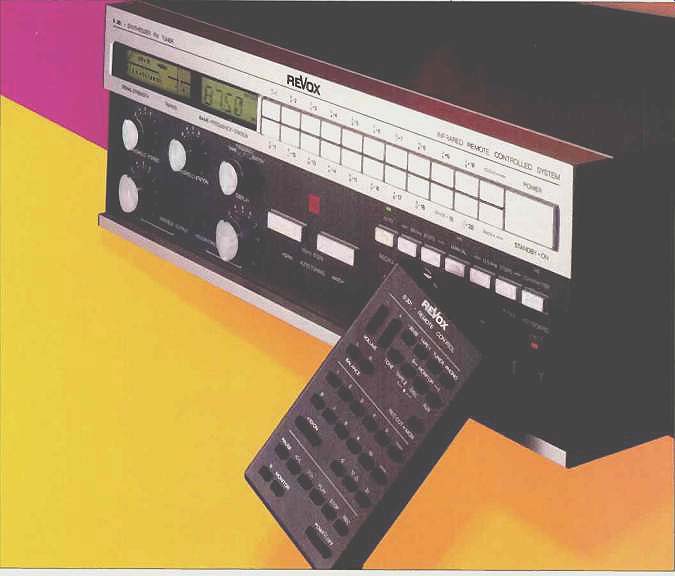
Manufacturer's Specifications:
Usable Sensitivity: Mono, 10.8 dBf; stereo, 31.2 dBf.
S/N: Mono. 80 dB; stereo, 76 dB.
THD: Mono, 0.10% at 1 kHz; 0.15% at 100 Hz; 0.2% at 6 kHz.
Frequency Response: 30 Hz to 15 kHz, ± 1 dB.
Stereo Separation: 40 dB at 100 Hz; 43 dB at 1 kHz; 40 dB at 10 kHz.
AM Rejection: 72 dB. Capture Ratio: 2.0 dB.
Alternate Channel Selectivity: 78 dB.
Image Rejection: 106 dB.
I.f. Rejection: 110 dB.
Spurious Rejection: 106 dB.
Subcarrier Suppression: 73 dB.
Output Level: Fixed, 2.0 V; variable, 8.8 V maximum.
Headphone Output Level: 6 V at 220-ohm impedance.
Power Requirements: 115 V, 50/ 60 Hz, 30 watts.
Dimensions: 17.72 in. (45 cm) W x 6.02 in. (15.3 cm) H x 13.07 in. (33.2 cm) D.
Weight: 18.7 lbs. (8.5 kg).
Price: $1,500.00.
Company Address: 1425 Elm Hill Pike, Nashville, Tenn. 37210, USA.
My first encounter with the Revox B261 FM tuner was during a visit to the Studer-Revox facilities near Zurich, Switzerland. I was extremely impressed with the unit then, even though I had a very short time to put it through its paces during that multi-city whirlwind tour of what Dr. Willi Studer had wrought since the founding of his world-renowned company. I ran into the B261 again, briefly. during the Summer Consumer Electronics Show last June, in Chicago. During that encounter, I learned a bit more about its amazing capabilities and convenience features, and about the long research and development program that preceded its realization. And now, at last, I have been able to check it out at my leisure, in my own lab. With superb tuners available at a fraction of the cost of the Revox B261, my chief concern was whether or not the $1,500.00 price of this Swiss-crafted tuner is justified. In two short words: It is! Like the matching integrated amplifier developed by Re vox as a companion piece to this tuner, the B261 is meant to be customized by the dealer (or by yourself, if you are willing to spend a few moments with the owner's manual, pushing the appropriate buttons on the front panel). By "customizing," I don't just mean entering the station frequencies in the tuner's 20-station memory (which can be in increments of as little as 12.5 kHz, necessary for some cable FM transmissions). You can also enter each station's call letters (up to four alphanumeric characters) so that next time you call up the station it will be identified in this manner (if you so choose) rather than by frequency.
You (or your dealer) can also program into the tuner's memory each of four operating modes to be associated with each of the memorized stations. These include stereo, high blend (to reduce noise when listening to weak stereo signals), mono and muting. If you have the optional second antenna input (a most impressive feature which I really regret was not included in my test sample), you can store the antenna input selection with each station's frequency in memory, so switching will be automatic. This can be useful if the stations in your area require two antenna orientations, or if you're getting some stations off the air and some from cable. All these programmed settings are protected from loss due to power failure or inadvertent disconnection, because they are stored in EAROM (Electrically-Alterable Read-Only-Memory), which is non-volatile and requires no battery backup. The 20 memorized stations can be scanned from the front panel or from the optional, infrared remote control, with the tuner sampling each station for a few seconds till you halt it.
There's also a 400-Hz calibration oscillator, whose output level is set at 6 dB below 100% modulation. This can be used to set tape recorder levels before the start of a program you want to tape.
Control Layout
The front-panel controls of the B261 are arranged in two distinct groups. The most frequently used controls are located in the upper half of the panel. Less frequently used controls (such as programming buttons, manual tuning buttons, etc.) are located in the lower section of the front panel, which can be covered with a clear, acrylic plastic panel to prevent tampering with preferred settings.
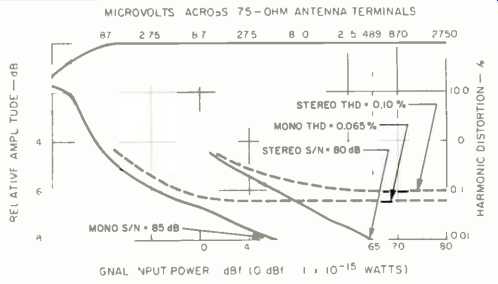
Fig. 1--Mono and stereo FM quieting and distortion characteristics.
Signal-strength and center-of-channel tuning meters are at the extreme upper left of the front panel. Why a center-of channel tuning meter for a frequency-synthesized tuner? Because if you are tuning to a cable FM signal, for example, and its frequency is not exactly what you thought it was, displacement of the center-tune meter needle from its center position will tell you to tune in smaller, 12.5-kHz increments for best reception.
A three-function display area near the meters shows either the selected station's frequency, its memory-key number or its call letters, selected by a knob immediately below.
Twenty memory buttons occupy the rest of the panel's upper section. They can be used not only to recall stations but to input either station frequencies or call letters, according to the way the "Keyboard" switch below is set. With that switch in "Character' mode, buttons 1 through 10 input the letters "A" through "J," while buttons 11 through 18 input either the letters "K' through "R" or, using button 20 as a shift key, the letters "S" through "Z." With the "Character" function turned off, buttons 1 through 10 are used to input the digits 1 through 0. Two other, unnumbered buttons handle back -and forward-space/Clear. Pressing a station button when the tuner is off will turn it on and bring that station up immediately; touching the large "Power" button at the upper right of the panel will turn the tuner on and recall the last station listened to.
Controls along the lower section of the front panel include an output level control, stereo and muting threshold controls, a display mode selector (station number, frequency or call letters), a stereo headphone jack and its associated output level control, up and down auto-tuning bars for station search, and, at the extreme right, a bank of 14 more small touch buttons, arranged in two rows of seven each. In the upper row, a "Recall" button activates the last station tuned with auto tuning. Two buttons provide incremental tuning in 12.5-kHz steps, while two more offer manual tuning in 50-kHz steps, up or down. Another button recalls the most recent manually tuned station. Still another button is used to change from character to number function for the upper keyboard.
The lower row of touch buttons includes a 400-Hz calibration tone switch, muting on/off switch, "Stereo Only" switch, "Separation/High Blend" switch, a "Mono On" selector, "Antenna" selector (active only if the dual-antenna option has been purchased), and a "Store" button which enters frequencies or call letters into the tuner's memory.
The rear panel of the B261 houses fixed and variable output jack pairs and a coaxial antenna input, for which a mating unwired plug was supplied in our sample. When I pointed out to the people at Revox in Nashville that most U.S consumers don't like to have to do any wiring to start using an audio component (apparently Europeans revel in this sort of "do-the-final-hookup-yourself" routine), I was assured that production units reaching dealers would have a suitable type of adaptor/transformer included, which would eliminate this nuisance. A European-style DIN connector (which would be handy for hookup to a tape deck) is provided in addition to the single-jack outputs. The rear panel also has a socket for connection of a remote power on cable from Revox's Model B710 cassette recorder. The optional remote-control unit will operate the tuner individually, as well as Revox's turntables, B251 amplifier, cassette recorder and even their B77 reel-to-reel tape recorder (which can be retrofitted for such remote operation). According to Revox, the wider utilization of microcomputer control in this tuner has made possible considerably simplified wiring. Serial buss connections result in fewer wires, contacts and solder connections, which should improve reliability.
Measurements
When I read the specifications in the owner's manual, I saw that specifications were quoted in accordance with European FM broadcasting techniques and standards. Realizing that American readers would not be able to compare these specs with my measured results, I quickly phoned Revox in Nashville to try to obtain equivalent U.S. performance specs. I was informed that none were presently available, but that they would telex Switzerland that day.
With typical Swiss efficiency, the Revox factory telexed the answers back within 12 hours, and the manufacturer's specs appearing at the beginning of this report are per EIA/ IHF U.S standards.
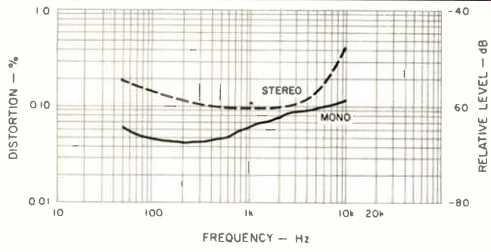
Fig. 2--Harmonic distortion vs. frequency.
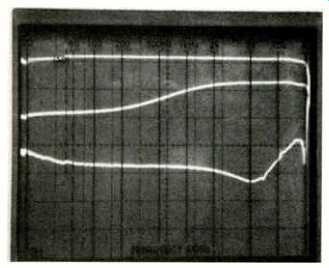
Fig. 3--FM frequency response (upper trace) and stereo separation vs. frequency
with "High Blend" control on (middle trace) and off (lower trace).
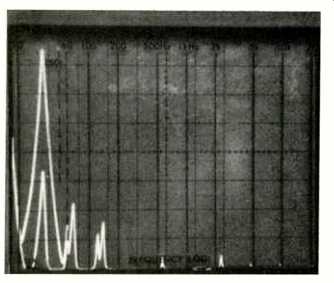
Fig. 4--Analysis of 5-kHz distortion and crosstalk.
Usable sensitivity measured 11.0 dBf in mono and 35 dBf n stereo, determined largely by the stereo switching threshold. It was necessary for me to use a transformer to get from my 50-ohm generator output impedance to the 75-ohm input impedance of the Revox B261. I suspect that this transformer introduced some losses, but the usable sensitivity figure obtained is certainly good enough. In any event, of far greater importance than usable sensitivity is the 50-dB quieting sensitivity, which Revox does not include in their published specifications. I measured 13.0 dBf for mono (that's equivalent to a very low 1.23 µV across 75 ohms) and 35 dBf (15.5 µV across 75 ohms) in stereo. Mono signal-to- noise measured a very high 85 dB, while in stereo the best S/N obtainable for a 65-dBf input signal was 80 dB. Harmonic distortion for strong signals measured a low 0.065% n mono and 0.1% in stereo. Noise and distortion at 1 kHz are plotted against input signal strength in Fig. 1, while Fig. 2 is a plot of harmonic distortion versus frequency for mono and stereo operation of the tuner, with a 65-dBf input signal. Figure 3 is a spectrum analysis 'scope photo of a frequency response sweep (upper trace) and sweeps of unmodulated stereo channel outputs (separation) with the high blend turned on (middle trace) and with the high-blend circuitry disabled (lower trace). Mid-frequency separation measured 42 dB, which is not unusually high for a modern stereo tuner, but, more remarkably, separation was maintained virtually at this high level across the entire frequency spectrum. I measured 40 dB of stereo separation at 100 Hz and 41 dB at 10 kHz.
Figure 4 is a linear sweep-frequency presentation, in which a 5-kHz signal modulated the left channel (represented by the tall spike at left). This was followed by a sweep of the output at the unmodulated channel, which shows dynamic 5-kHz separation (the shorter spike nested inside the taller one) of around 40 dB (each vertical division in the 'scope photo is worth 10 dB) and higher frequency crosstalk and subcarrier output products. Horizontal calibration is 5 kHz per linear division, and the 19and 38-kHz "blips" representing subcarrier product output were about the lowest I have seen for any tuner ever tested-around 70 dB below 100% modulation. Using this tuner to record FM programs on tape, you are never likely to have to turn on a multiplex filter on your tape deck! I was able to measure a far better capture ratio for this tuner than was claimed by typically conservative Revox. The best figure I obtained was 1.0 dB; it is possible that our measurement methods differed. Selectivity measured better than the 78 dB claimed. I was able to obtain a reading of 83 dB for alternate channel selectivity. As for the various rejection ratios (spurious, i.f. and image), they all measured better than 100 dB, the limits of my test equipment. Muting level, for suppression of interstation noise and elimination of weak signals, was adjustable over a range from 27 to 51 dBf, while stereo threshold was adjustable over a range from 35 to 70 dBf. SCA rejection, like subcarrier product rejection, was better than 70 dB. A point-by-point check of frequency response, using more sensitive instrumentation than was used for Fig. 3, revealed that deviation from perfectly flat response (based upon 75-p.S pre-emphasis and de-emphasis) never exceeded 0.5 dB from 30 Hz to 15 kHz. When I limited the frequency range to 100 Hz to 10 kHz, deviation was never more than 0.1 dB from flat.
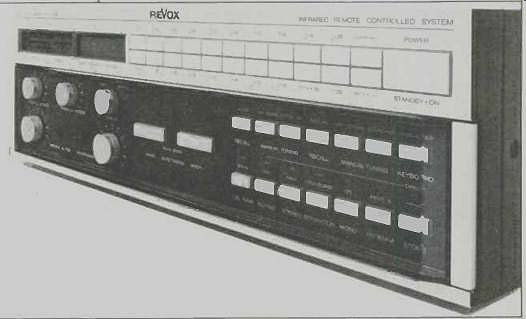
above: Controls for those tuner operating parameters which are usually
seldom adjusted, have been placed beneath a transparent acrylic plastic cover
to protect them from casual or inadvertent changes.
Use and Listening Tests
Whether the Revox B261 is suitable for you or not depends a great deal upon how you listen to FM radio and how you feel about the luxurious features which this tuner provides. There's the matter of long-term reliability to consider too. If you are at all familiar with Revox tape recorder products, you know they are as close to being indestructible as any electromechanical product can be. A Revox tuner, built with the same precision and the same margin of safety and conservatism, has the additional advantage of not having any moving parts. One could therefore expect it to operate perfectly for an even longer period of time than is the case with Studer and Revox tape equipment.
Clearly, the performance capabilities of the B261 were beyond those of any FM station that I can receive in my listening area, and that's likely to be true wherever you happen to be. But then again, that there are few roads in the United States on which you can extract the full performance of a Rolls-Royce or a BMW or a Mercedes automobile, doesn't stop thousands of lovers of fine cars from buying and driving them. I'll admit that I happen to have a particular fondness for good FM tuner products. Perhaps it dates back to the days when I worked with one of the greatest FM design engineers who ever lived, Murray Crosby. In any event, I confess that I am turned on by a tuner such as this Revox B261-by the thoughtfulness that went into its design, its layout, and the way it obeys my every wish. I would guess that two types of FM listeners will flock to this remarkable tuner: Those who are affluent enough not to have to worry about its price, and those who appreciate the superb blending of computer and r.f. technology that went into its design: The former group may well allow the dealer to "program" the tuner for them, as Revox suggests, and will leave the clear acrylic cover on the bottom half of the panel.
The latter group (and that includes this reviewer) won't leave that cover on for five seconds, as they explore the remarkable versatility and adjustment capabilities of this extraordinary product.
-Leonard Feldman
(Source: Audio magazine, Dec. 1983)
Also see: Revox B286 Tuner/Preamp (Dec. 1986)
Revox B260 FM Tuner (Sept 1988)
Revox B215 Cassette Deck (July 1985)
= = = =